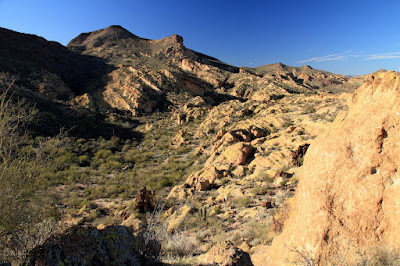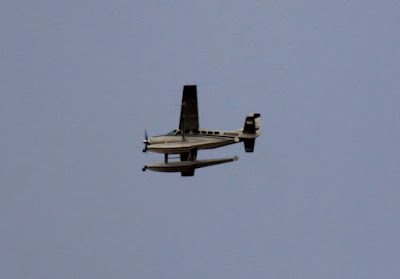I went back to a part of Bulldog Canyon in which I had hiked
about a year ago. Interestingly, in the current (January) issue of Scientific American, Michael Shermer comes to the same conclusion as I did then regarding the computer intelligence singularity, i.e. it will always be a few more years away. I would suspect that he was reading my blog and stealing my ideas if it wasn't such an obvious conclusion. (Plus, I can't imagine contributors to Scientific American doing such things.) Anyway, I thought that was interesting. Now back to the hike.

I took my favorite picture of the outing while I was still driving to the "trailhead".
I've got a couple of weeks off of work and had all sorts of plans for places I was going to go. The time off started last Saturday (the 17th). I got out of bead early that morning, reached down to pick up my phone, and my lower back went *sproing*. I hate it when that happens. It's just as well, though. The next few days were gloomy and wet, so I wouldn't have done much hiking anyway.
This is a scenic walk down a nameless wash (intermittent stream). I'm guessing that I walked about 8 miles. Can't tell for sure because the PN-40 discarded part of my track, and it was a part where I should have had excellent satellite coverage. Well, I could figure it out, but I'm feeling pretty lazy today. I'll never count on this receiver for breadcrumbs, though. It felt like a long walk. My ankles are achy today.

I saw places I want to go explore on my way down the wash. Some day.
The last time I was down there, I took a lot of pictures of puddles. We've had a lot of rain recently, so there were even more puddles. I told myself that I had enough pictures of puddles, though, and I wasn't going to take pictures of any more puddles unless they just happened to be in a good spot and looked good. I wound up with a lot of pictures of puddles again, anyway.

I think I got a picture of this puddle the last time I was out here.
A year ago, I could see some evidence of vehicles having driven down the wash. According to the Forest Service map, they shouldn't be there. I parked at the end of the official road, which is indistinguishable from the non-road that continues to the north. In January, it looked like only a small number of vehicles had gone very far down the wash beyond the end of the road, and there hadn't been any there for at least a couple of weeks. This time, it looked like there had been heavy traffic along most of the wash and there had been multiple vehicles out there the same day I was there (though I didn't see them).
I "hurried" at the beginning of the hike because I wanted to get to the view of the cliff that I like so much while there was still sunshine, and I had gotten a late start (long story). It seemed to be further to that cliff than I remembered, but it was just as pretty.

My primary destination.
After getting more pictures of the cliff, I had enough charge in the camera battery and enough sunshine (or so I thought) to continue downstream. Along the way, I found a small natural cave in a canyon wall. It was pretty dark in there, but I made a movie. There were what looked like fresh tennis shoe prints in the dust on the floor of the cave, but water doesn't get in there unless there's a huge flood and it's probably difficult for wind to blow through there, too.
From one end to the other of a small cave. Surprisingly, the PN-40 did not choke to death while I was in there.
I went all the way to where the wash intersected another wash that is very popular with ATV and 4WD enthusiasts, but is also not an official road. From the cliff to the other wash was rough and slow-going. I noticed a few things about plants that grow in stream beds there, too. There are almost no cacti in stream beds. There are many types of plants there that have no thorns. Some have thorns, but you can brush bare skin against them without getting a scratch. Then there's catclaw acacia. It's thorns are curved, like cat's claws. It takes just the slightest touch, and the claw grabs you. If you move, more claws grab you. If you move more, they sink in and rip flesh, so you don't want to pull away from one because it will rip you to shreds. You have to move towards it to get unhooked, but that just allows more claws to make contact, and they aren't going to let go easily.
The harmless plants are scattered here and there. You could brush up against them if you wanted too, but you almost never have to. Even when you get to a choke point, where there is only one possible route through, there are rarely harmless plants there. Those special places seem to be reserved for catclaw acacia. So you're clambering over slippery rocks and trying to avoid falling in a puddle and you have to drop the last foot or two and guess what grabs you just as you start to drop. Every time. Riiiiip rip rip rip riiip rip. Usually, I try to ignore the results, unless the blood runs down to my fingertips. Then I try to keep from getting blood on my camera. What adds insult to injury is when pesky gnats move in to feast on the blood. Fortunately, there were no gnats this day. I often get home from hikes and pull catclaw thorns out of my arms as I shower. I guess the best thing that can be said about catclaw is that, once it's embedded in your flesh, it doesn't release chemicals that cause pain (the way rose thorns do).

Catclaw got my nose. Ouch.
The sun had set by the time I got back to the cliff that was my original destination. It was quickly getting too dark for pictures, so I didn't have to stop to take many more. I was getting tired, though. My legs ached. I concentrated on moving steadily ahead, without stumbling. I didn't want to look like easy pickings to a hungry cat. I had to squat down occasionally, though, for a short rest and to stretch the muscles that were aching. This is when I discovered an advantage to having hurt my back a few days earlier. I had to keep my back straight up and down. That meant that any time I needed something off the floor, I used only my legs. It's surprising how much stronger they had gotten from a few days of picking up newspapers, dropped items, and Emily like that. My legs never got tired of pushing me uphill on that hike.

I like the way some pictures taken in the dark turned out.
After a while, it got hard to see any detail in the bed of the wash. No moon. I could tell where water was, where sand was, and where solid rock was, but that was about it. The solid rock became dangerous to walk on, because I couldn't see the ripples in it, and I wound up stumbling a couple of times. I had to resort to using a flashlight. I used the one my younger sister gave me a few years ago. It's a single LED. Bright enough to see the texture, but not so bright as to destroy my night vision. It was perfect. I got to the truck about 150 yards after getting the flashlight out. Click below to see all of the pictures.




















































